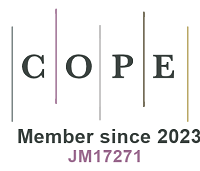REFERENCES
1. Thompson RC, Moore CJ, vom Saal FS, Swan SH. Plastics, the environment and human health: current consensus and future trends. Philos Trans R Soc Lond B Biol Sci 2009;364:2153-66.
2. Plastics Europe. Plastics - the fast facts 2023. Available from: https://plasticseurope.org/knowledge-hub/plastics-the-fast-facts-2023/. [Last accessed on 9 Nov 2024].
3. Ter Halle A, Jeanneau L, Martignac M, et al. Nanoplastic in the North Atlantic subtropical gyre. Environ Sci Technol 2017;51:13689-97.
4. Kalčíková G, Skalar T, Marolt G, Jemec Kokalj A. An environmental concentration of aged microplastics with adsorbed silver significantly affects aquatic organisms. Water Res 2020;175:115644.
5. Granek EF, Brander SM, Holland EB. Microplastics in aquatic organisms: improving understanding and identifying research directions for the next decade. Limnol Oceanogr Lett 2020;5:1-4.
6. Bucci K, Tulio M, Rochman CM. What is known and unknown about the effects of plastic pollution: a meta-analysis and systematic review. Ecol Appl 2020;30:e02044.
7. Laist DW. Impacts of marine debris: entanglement of marine life in marine debris including a comprehensive list of species with entanglement and ingestion records. In: Coe JM, Rogers DB, editors. Marine debris. New York: Springer; 1997. pp. 99-139.
8. Revel M, Roman C, Châtel A. Is cell culture a suitable tool for the evaluation of micro- and nanoplastics ecotoxicity? Ecotoxicology 2021;30:421-30.
9. Campanale C, Dierkes G, Massarelli C, Bagnuolo G, Uricchio VF. A relevant screening of organic contaminants present on freshwater and pre-production microplastics. Toxics 2020;8:100.
10. Peng J, Wang J, Cai L. Current understanding of microplastics in the environment: occurrence, fate, risks, and what we should do. Integr Environ Assess Manag 2017;13:476-82.
11. Crew A, Gregory-Eaves I, Ricciardi A. Distribution, abundance, and diversity of microplastics in the upper St. Lawrence River. Environ Pollut 2020;260:113994.
12. Karlsson TM, Vethaak AD, Almroth BC, et al. Screening for microplastics in sediment, water, marine invertebrates and fish: method development and microplastic accumulation. Mar Pollut Bull 2017;122:403-8.
13. Battin TJ, Besemer K, Bengtsson MM, Romani AM, Packmann AI. The ecology and biogeochemistry of stream biofilms. Nat Rev Microbiol 2016;14:251-63.
14. Kalčíková G, Bundschuh M. Aquatic biofilms-sink or source of microplastics? A critical reflection on current knowledge. Environ Toxicol Chem 2022;41:838-43.
15. Guasch H, Bernal S, Bruno D, et al. Interactions between microplastics and benthic biofilms in fluvial ecosystems: knowledge gaps and future trends. Freshw Sci 2022;41:442-58.
16. Merbt SN, Kroll A, Tamminen M, et al. Influence of microplastics on microbial structure, function, and mechanical properties of stream periphyton. Front Environ Sci 2022;10:928247.
17. Miao L, Hou J, You G, et al. Acute effects of nanoplastics and microplastics on periphytic biofilms depending on particle size, concentration and surface modification. Environ Pollut 2019;255:113300.
18. Wagner M, Lambert S. Freshwater microplastics: emerging environmental contaminants? Springer International Publishing: Cham; 2018.
19. Krause S, Baranov V, Nel HA, et al. Gathering at the top? Environmental controls of microplastic uptake and biomagnification in freshwater food webs. Environ Pollut 2021;268:115750.
20. Wang B, Lan X, Zhang H, Hu Y. Benthic biofilms in riverine systems: a sink for microplastics and the underlying influences. Environ Pollut 2023;337:122607.
21. Chatterjee S, Krolis E, Molenaar R, Claessens MM, Blum C. Nile red staining for nanoplastic quantification: overcoming the challenge of false positive counts due to fluorescent aggregates. Environ Chall 2023;13:100744.
22. Gallitelli L, Cera A, Cesarini G, Pietrelli L, Scalici M. Preliminary indoor evidences of microplastic effects on freshwater benthic macroinvertebrates. Sci Rep 2021;11:720.
23. Osman DM, Yuan W, Shabaka S, et al. The threat of micro/nanoplastic to aquatic plants: current knowledge, gaps, and future perspectives. Aquat Toxicol 2023;265:106771.
24. Triebskorn R, Braunbeck T, Grummt T, et al. Relevance of nano- and microplastics for freshwater ecosystems: a critical review. TrAC Trend Anal Chem 2019;110:375-92.
25. Castaño-Ortiz JM, Romero F, Cojoc L, et al. Accumulation of polyethylene microplastics in river biofilms and effect on the uptake, biotransformation and toxicity of the antimicrobial triclosan. Environ Pollut 2024;344:123369.
26. Holzer M, Mitrano DM, Carles L, Wagner B, Tlili A. Important ecological processes are affected by the accumulation and trophic transfer of nanoplastics in a freshwater periphyton-grazer food chain. Environ Sci Nano 2022;9:2990-3003.
27. MELCCFP. Lake Saint-Pierre, a jewel to be restored. 2013. (in French). Available from: https://belsp.uqtr.ca/id/eprint/421. [Last accessed on 9 Nov 2024].
28. RSIS Lake Saint-Pierre. Ramsar sites information service. (in French). Available from: https://rsis.ramsar.org/fr/ris/949. [Last accessed on 9 Nov 2024].
29. Doucet C, Girard C, Clément-Robert G, Slevan-Tremblay I, Royer Boutin P, Boissonneault Y. Regional integrated management plan for Lake Saint-Pierre. 2018. (in French). Available from: https://belsp.uqtr.ca/id/eprint/1428/1/TCRLSP%201_2018_%20Plan_gestion_int%c3%a9gr%c3%a9e_A.pdf. [Last accessed on 9 Nov 2024].
30. Lalonde S, Cusson B, Longpré D. Current state of knowledge regarding the vegetation on the south shore of Lake Saint-Pierre. 2003. (in French). Available from: https://belsp.uqtr.ca/id/eprint/331/1/Lalonde%20et%20al_2003_vegetation%20rive%20sud%20lac%20St-Pierre_A.pdf. [Last accessed on 9 Nov 2024].
31. Richard G, Côté D, Mingelbier M, Jobin B, Morin J, Brodeur P. Land cover of the Lake Saint-Pierre (St. Lawrence River) floodplain between the years 1950, 1964 and 1997: interpretation of aerial photographs, digitation and preparation of a georeferenced database. (in French). Available from: https://belsp.uqtr.ca/id/eprint/497/. [Last accessed on 9 Nov 2024].
32. TCRLSP. Fact sheet regarding improvements to water quality in Lake Saint-Pierre. 2018. (in French). Available from: https://belsp.uqtr.ca/id/eprint/1432/1/TCRLSP%204_2018_qualit%C3%A9_eau_Fiche%20synth%C3%A8se_A.pdf. [Last accessed on 9 Nov 2024].
33. TCRLSP. Introductory document to the regional integrated management plan for Lake Saint-Pierre, 2018. (in French). Available from: https://belsp.uqtr.ca/id/eprint/1428. [Last accessed on 9 Nov 2024].
34. Restoration of Habitats in Lake Saint-Pierre: a prerequisite for recovery of the Yellow Perch. natcan 2014;138:50-61.
35. Moraz A, Breider F. Detection and quantification of nonlabeled polystyrene nanoparticles using a fluorescent molecular rotor. Anal Chem 2021;93:14976-84.
36. Gagné F. Detection of polystyrene nanoplastics in biological tissues with a fluorescent molecular rotor probe. J Xenobiot 2019;9:8147.
37. Gagné F, Roubeau-Dumont E, André C, Auclair J. Micro and nanoplastic contamination and its effects on freshwater mussels caged in an urban area. J Xenobiot 2023;13:761-74.
38. Description des caractéristiques du lac Saint-Pierre. Source: Ministère de l’Environnement et de la Faune, Lac Saint-Pierre. Fiche d’information sur les zones humides Ramsar, 1998, pp. 1-3. Available from: https://oraprdnt.uqtr.uquebec.ca/portail/gscw031?owa_no_site=665&owa_no_fiche=109. [Last accessed on 9 Nov 2024].
39. Genovese A, Hudon C, Martel AL, Cattaneo A. Molluscan assemblages under multiple stressors in a large fluvial lake. Fund Appl Limnol 2016;188:289-307.
40. Villemure I. I Impact of trophic exposure to a major municipal effluent on the physiological responses of two mobile predator fish species. Theses, University of Quebec in Trois-Rivières: Trois-Rivières, 2015. Available from: https://depot-e.uqtr.ca/id/eprint/7801/1/031118297.pdf. [Last accessed on 9 Nov 2024]
41. Li J, Liu H, Paul Chen J. Microplastics in freshwater systems: a review on occurrence, environmental effects, and methods for microplastics detection. Water Res 2018;137:362-74.
42. Thiele CJ, Hudson MD, Russell AE. Evaluation of existing methods to extract microplastics from bivalve tissue: adapted KOH digestion protocol improves filtration at single-digit pore size. Mar Pollut Bull 2019;142:384-93.
43. Morgana S, Casentini B, Tirelli V, Grasso F, Amalfitano S. Fluorescence-based detection: a review of current and emerging techniques to unveil micro/nanoplastics in environmental samples. TrAC Trend Anal Chem 2024;172:117559.
44. Monteleone A, Brandau L, Schary W, Wenzel F. Using autofluorescence for microplastic detection - Heat treatment increases the autofluorescence of microplastics1. Clin Hemorheol Microcirc 2020;76:473-93.
45. Lee CH, Fang JK. Effects of temperature and particle concentration on aggregation of nanoplastics in freshwater and seawater. Sci Total Environ 2022;817:152562.
46. Peiponen KE, Roussey M. Prediction of nanoplastics aggregation in wastewaters. Water Emerg Contam Nanoplastics 2023;2:12.
47. Pradel A, Catrouillet C, Gigault J. The environmental fate of nanoplastics: what we know and what we need to know about aggregation. NanoImpact 2023;29:100453.
48. Katsumiti A, Losada-Carrillo MP, Barros M, Cajaraville MP. Polystyrene nanoplastics and microplastics can act as Trojan horse carriers of benzo(a)pyrene to mussel hemocytes in vitro. Sci Rep 2021;11:22396.
49. Jakubowicz I, Enebro J, Yarahmadi N. Challenges in the search for nanoplastics in the environment - a critical review from the polymer science perspective. Polym Test 2021;93:106953.
50. Choi S, Lee S, Kim MK, Yu ES, Ryu YS. Challenges and recent analytical advances in micro/nanoplastic detection. Anal Chem 2024;96:8846-54.
51. Huber MJ, Ivleva NP, Booth AM, et al. Physicochemical characterization and quantification of nanoplastics: applicability, limitations and complementarity of batch and fractionation methods. Anal Bioanal Chem 2023;415:3007-31.
52. Okoffo ED, Thomas KV. Quantitative analysis of nanoplastics in environmental and potable waters by pyrolysis-gas chromatography-mass spectrometry. J Hazard Mater 2024;464:133013.
53. Wang X, Li Y, Kroll A, Mitrano DM. Differentiating microplastics from natural particles in aqueous suspensions using flow cytometry with machine learning. Environ Sci Technol 2024;58:10240-51.
54. Chakraborty N, Silswal A, Koner AL. Julolidine-based fluorescent molecular rotor: a versatile tool for sensing and diagnosis. Sens Diagn 2024;3:585-98.
55. Comité ZIP of Lake Saint-Pierre Summary sheet on improving water quality in Lake Saint-Pierre. 2018. (in French). Available from: https://belsp.uqtr.ca/id/eprint/1432/1/TCRLSP%204_2018_qualit%C3%A9_eau_Fiche%20synth%C3%A8se_A.pdf. [Last accessed on 9 Nov 2024].
56. He B, Smith M, Egodawatta P, Ayoko GA, Rintoul L, Goonetilleke A. Dispersal and transport of microplastics in river sediments. Environ Pollut 2021;279:116884.
57. Hale RC, Seeley ME, La Guardia MJ, Mai L, Zeng EY. A global perspective on microplastics. JGR Oceans 2020;125:e2018JC014719.
58. Eerkes-Medrano D, Thompson RC, Aldridge DC. Microplastics in freshwater systems: a review of the emerging threats, identification of knowledge gaps and prioritisation of research needs. Water Res 2015;75:63-82.
59. COGESAF. Water master plan for the Saint-François River watershed. 2014. (in French). Available from: https://cogesaf.qc.ca/PDE/COGESAF_PDE_2014-2023.pdf. [Last accessed on 9 Nov 2024].
60. MRC. Haute Yamaska Revised water master plan (2017-2021) - For healthy lakes and streams in Haute-Yamaska. 2017. (in French). Available from: https://haute-yamaska.ca/wp-content/uploads/2018/08/PDE-version-finale_3-mai-2018-web.pdf. [Last accessed on 9 Nov 2024].
61. Granby. Industrial business directory. (in French). Available from: https://granby-industriel.com/entreprises/. [Last accessed on 9 Nov 2024].
62. MRC. Maskinongé Revised land use and development plan. Plan 9.9C - Maskinongé: Lake Saint-Pierre shoreline zoning. 2022. (in French). Available from: https://mrcmaskinonge.ca/wp-content/uploads/schema-amenagement-plan-9-9c.pdf?v=1620672520. [Last accessed on 9 Nov 2024].
63. MELCCFP. Loadings of six physicochemical and bacteriological parameters at the mouth of the main tributaries of the St. Lawrence River - 2013-2017. 2024. (in French). Available from: https://www.environnement.gouv.qc.ca/Eau/flrivlac/physicochimie-bacteriologie/rapport-charges-six-paramettres-physicochimiques-bacteriologique.pdf. [Last accessed on 9 Nov 2024].
64. Uddin S, Fowler SW, Habibi N, Behbehani M. Micro-nano plastic in the aquatic environment: methodological problems and challenges. Animals 2022;12:297.







